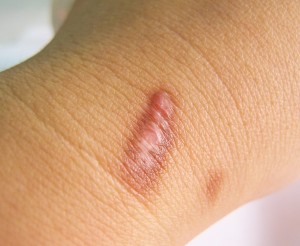 Keloid scars, like any other type of scar, is the result of an injury to the skin. It occurs when fibrous scar tissue forms excessively on the injury site. The scar is characterized as being a smooth and irregularly shaped growth. Unlike normal flat scars, keloids tend to get larger over time.
Keloid scars, like any other type of scar, is the result of an injury to the skin. It occurs when fibrous scar tissue forms excessively on the injury site. The scar is characterized as being a smooth and irregularly shaped growth. Unlike normal flat scars, keloids tend to get larger over time.
No matter how big they grow, keloid scars do not pose any problem to your health. To get rid of your keloid scars, the following treatment options (alone or in combination) should help you:
Silicone Sheets
If you are looking for at-home remedies, silicone sheets are your best bet. These sheets are very easy to use and they have to be put on the affected area regularly. It will take months to see results so a bit of patience is needed. Results vary among patients but you will see improvements in the appearance and size of the keloid scar.
Cortisone Injections
Cortisone can be injected directly into the keloid scar to help flatten it. The treatment is safe and effective and usually requires multiple injections that must be given once every four weeks. It must be noted that while cortisone can make the scar smaller, it can also make it redder due to the increased formation of superficial blood vessels. Cortisone injections make keloid scars look much better after treatment but there will always be a mark left that looks and feels different than the rest of the skin.
In the case of large keloids, the injections can be used only to soften the scar and make it easier to remove via surgical excision.
Laser Treatment
Laser treatment is also effective in flattening keloid scars without the redness associated with a cortisone injection. In fact, they make the affected area look less red. The treatment is safe and virtually painless but several sessions might be required to see the effects. Laser treatment is not usually covered by health insurance plans and can be quite expensive.
Interferon
Interferon is a protein synthesized by the immune system to combat viruses, bacteria and other parasites. It also works against tumor cells. According to studies, Interferon, can help reduce the size of the scar when injected into the keloid. However, researchers are not certain whether or not this effect is long-lasting. A variant of this treatment which involves the application of a topical drug called imiquimod is currently being studied.
Surgery
The best way to get rid of keloid scars is to remove them via surgical excision. However, it should only be considered if all other treatment methods fail to produce results. Surgery can be pretty risky as cutting up a keloid scar may lead to the formation of an even bigger growth. Some surgeons prevent such risks by injecting cortisone into the area after the surgery or by placing compressive dressings over the wound for at least a month. In cases of extremely large and disfiguring keloids, surgery in combination with radiation therapy is suggested. Radiation helps lower recurrence rates.
Natural Home Remedies
If you like using natural remedies for health and cosmetic issues, you can try to get rid of keloid scars by rubbing them with lavender oil, lemon, honey and apple cider vinegar. These natural remedies help soften the scar and prevent them from reappearing. You have to use them daily in order to be effective. The results won’t be as fast as the other methods but they are a good alternative if you don’t want to use the methods listed above.
Unfortunately, keloid scarring is one of the most challenging conditions to treat successfully. No treatment is 100% effective in treating keloids. Remember that even with the best treatments available, recurrence is still a possibility and can occur several years after the first scars have disappeared.
– AA
